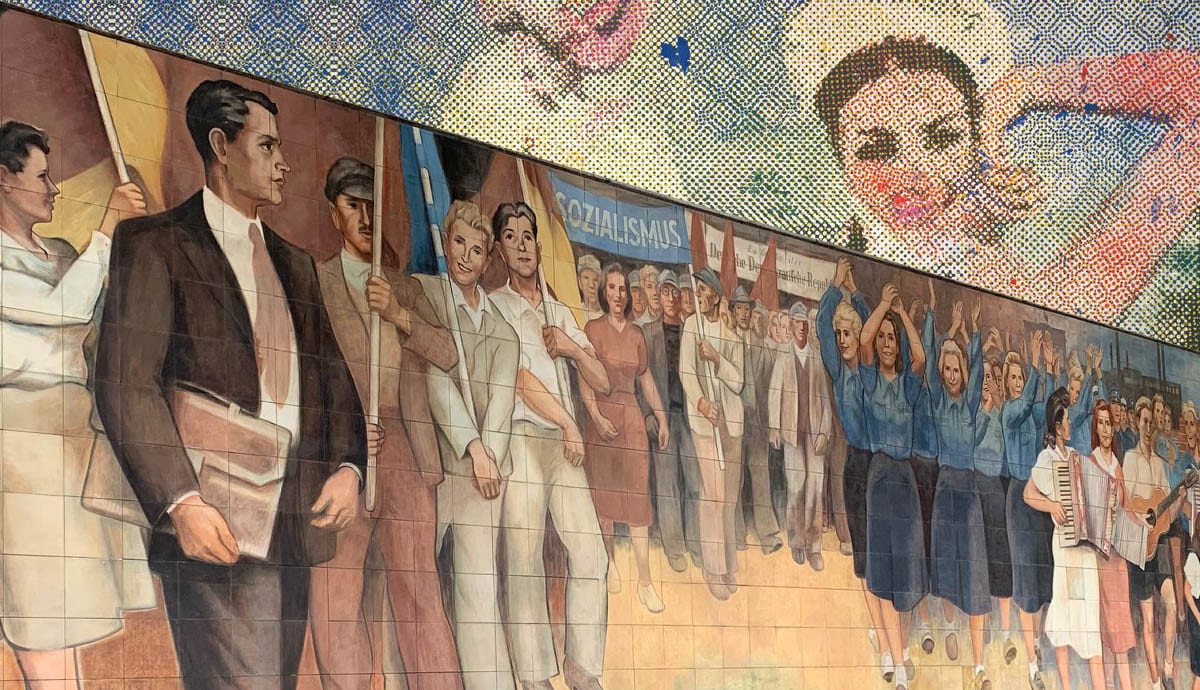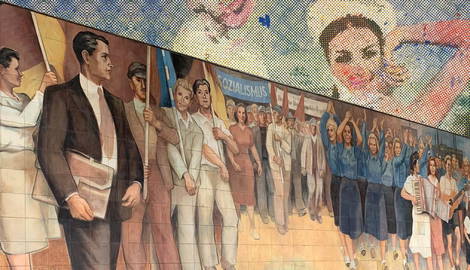
Capitalist Realism is an unusual, slippery art movement that defies easy definition. Part Pop Art, part Fluxus, part Neo-Dada, part Punk, the style came out of West Germany in the 1960s and was the springboard for some of today’s most astonishing and successful artists, including Gerhard Richter and Sigmar Polke. Emerging out of West Berlin in the mid-1960s, the Capitalist Realists were a rogue bunch of artists who had been raised in a troubled post-war society and took a suspicious, skeptical attitude to much of the imagery that surrounded them. They were on the one hand aware of American Pop Art, but also equally distrustful of the way it glorified commercialism and celebrity culture.
Much like their American contemporaries, they mined the realms of newspapers, magazines, advertisements, and department stores for subject matter. But in contrast with the brash, bright optimism of American Pop Art, Capitalist Realism was grittier, darker, and more subversive, with subdued colors, strange or deliberately banal subject matter, and experimental or informal techniques. The discomforting atmosphere of their art reflected Germany’s complicated and divided political status in the wake of the Second World War, and throughout the silently raging Cold War.
The History Of Capitalist Realism

Still divided by the Berlin Wall into East and West factions, 1960s Germany was a divisive and troubled country. In the East, ties with the Soviet Union meant art was expected to follow the propaganda style of Socialist Realism, promoting rustic, rural Soviet life with a rose-tinted, optimistic glow, as exemplified in German artist Max Lingner’s famous mosaic mural Building of the Republic, 1950-53. West Germany, by contrast, was more closely tied with the increasingly capitalistic and commercialized cultures of Britain and America, where a broad array of artistic practices were emerging, including Pop Art.

Dusseldorf Art Academy in West Berlin was recognized as one of the world’s leading art institutions in the 1960s, where artists including Joseph Beuys and Karl Otto Gotz taught a series of radical new ideas, from Fluxus performance art to expressive abstraction. Four students who met here in the 1960s would go on to found the Capitalist Realism movement – they were Gerhard Richter, Sigmar Polke, Konrad Lueg, and Manfred Kuttner. As a group, these artists were aware of developments in American Pop Art through reading international journals and publications. Andy Warhol’s integration of consumerist culture into art as seen in his Campbell’s Soup Cans, 1962, was influential, as were Roy Lichtenstein’s enlarged comic book excerpts featuring idealized, glamorous women painted with Ben-Day dots such as Girl in a Mirror, 1964.

In 1963, Lueg, Polke, and Richter staged a strange, experimental pop-up performance and exhibition in an abandoned butcher’s shop, showcasing a series of lo-fi paintings by each artist based on ad-hoc magazine advertisements. In the press release they described the display as “the first exhibition of German Pop Art,” but they were half-joking, as their artworks poked fun at the glossy sheen of American Pop Art. Instead, they focused on banal or horrible images in the public eye, a mood that was emphasized by the grim butcher’s shop setting.

Later in the same year, Gerhard Richter and Konrad Lueg staged another strange pop-up event, this time in Germany’s well-known Mobelhaus Berges furniture store, which included a series of bizarre performances on raised chairs and the display of paintings and sculptures amongst the store’s furniture. Papier-mache figures of American President John F. Kennedy and the renowned art dealer Alfred Schmela welcomed visitors to the gallery. They were a satirical take on Pop Art’s celebration of celebrity with these deliberately crude, unappealing caricatures.

They titled the event “Living with Pop – A Demonstration for Capitalist Realism,” and it was here that the name of their movement was born. The term Capitalist Realism was a tongue-in-cheek amalgamation of capitalism and Socialist Realism, referring to the two divisive factions of German society – the capitalist West and the Socialist Realist East. It was these two opposing ideas that they were attempting to play with and critique within their art. The irreverent name also revealed the self-effacing, dark humor that underpinned their practices, as Richter explained in an interview, “Capitalist Realism was a form of provocation. This term somehow attacked both sides: it made Socialist Realism look ridiculous, and did the same to the possibility of Capitalist Realism as well.”

In the years that followed the movement gathered a second wave of members with the help of the young gallerist and dealer René Block, who arranged a series of group displays in his eponymous West Berlin gallery space. In contrast with their painterly predecessors, these artists were more digitally focused, as seen in the work of Wolf Vostell and K.P. Brehmer. Block also arranged the production of affordable editioned prints and pioneering publications through his platform ‘Edition Block,’ launching the careers of Richter, Polke, Vostell, Brehmer, and many others, as well as supporting the development of Joseph Beuys’ practice. By the 1970s he was recognized as one of the most influential gallerists of post-war German art.

While Capitalist Realism gradually dissolved in the later 1970s, many of the artists associated with the movement continued to take similar ideas in bold and provocative new directions, and have since become world-leading artists. Let’s take a look through the most distinctive artworks that encapsulate this rebellious strand of German Pop Art, and how they set a solid foundation for some of today’s most celebrated artists.
1. Gerhard Richter, Mother and Child, 1962

One of the most famous painters in the world today, German artist Gerhard Richter laid the foundations for his future career with the Capitalist Realist movement in the early 1960s. The relationship between painting and photography has been the primary concern throughout his career, a duality he has explored in a wide array of experimental approaches. In the eerie painting Mother and Daughter, 1965, he explores his trademark ‘blur’ technique, making a photoreal painting resemble an out of focus photograph by fluffing the edges of the paint with a soft brush, lending it a ghostly, sinister quality.
For Richter, this blurring process created a deliberate distance between image and viewer. In this work, a seemingly ordinary found photograph of a glamorous mother and daughter is obscured into an indistinct haze. This process highlights the superficial nature of images from the public eye, which rarely tell us the whole truth. Writer Tom McCarthy notes in relation to Richter’s process, “What is a blur? It’s a corruption of an image, an assault upon its clarity, one that turns transparent lenses into opaque shower curtains, gauzy veils.”
2. Sigmar Polke, Girlfriends (Freundinnen) 1965/66

Like Richter, Sigmar Polke enjoyed playing with the dualities between printed images and painting. His rasterized dotted patterns as seen in this painting became a defining feature throughout his long and hugely successful career as a painter and printmaker. At first glance, his dots resemble American Pop artist Roy Lichtenstein’s comic-book style, ink-saving Ben-Day dots. But where Lichtenstein replicated the slick, polished, and mechanized finish of an industrially produced comic book, Polke chooses instead to replicate in paint the uneven results obtained from enlarging an image on a cheap photocopier.
This lends his work a grittier and more unfinished edge, and it also obscures the content of the original image so we are forced to focus on the surface dots rather than the image itself. Like Richter’s blur technique, Polke’s dots emphasize the flatness and two-dimensionality of the mediated, photographic images of glossy advertising, highlighting their superficiality and inherent meaninglessness.
3. K.P. Brehmer, Untitled, 1965

German artist K.P. Brehmer was part of the second-generation Capitalist Realists promoted by gallerist René Block throughout the 1960s. He took a multi-layered approach to image-making, combining excerpts of found imagery with blocks of abstract, modulated color. Various references to the idealized American life are concealed and obscured within this striking offset commercial print, including images of astronauts, stylish interior objects, car parts, and an objectified female model. Merging these images with blocks of abstract color takes them out of context and renders them mute, thereby highlighting their superficiality. Brehmer was interested in making printed artworks like this one that could be reproduced multiple times with minimal cost, a mindset that echoed René Block’s interest in the democratization of art.
4. Wolf Vostell, Lipstick Bomber, 1971

Like Brehmer, Vostell was part of the second generation of Capitalist Realists who focused on digital and new media techniques including printmaking, video art, and multi-media installation. And much like his fellow Capitalist Realists, he incorporated mass-media references within his work, often including imagery related to real instances of extreme violence or threat. In this controversial and unsettling image, he combines a well-known image of a Boeing B-52 plane as it dropped bombs over Vietnam. The bombs are replaced by rows of lipsticks, a reminder of the dark and unsettling truths that are often masked behind the gloss and glamour of capitalist consumerism.
Later Developments In Capitalist Realism

Widely recognized as Germany’s response to the phenomenon of Pop Art, the legacy of Capitalist Realism has been long-lasting and significant around the world. Both Richter and Polke went on to become two of the art world’s most celebrated international artists, while their art has inspired generations of artists to follow. Both Richter and Polke’s interrogation of the interwoven relationship between painting and photography has been particularly influential on a wide array of artists, from Kai Althoff’s curious narrative paintings to Marlene Dumas’ disturbing and unsettling painterly motifs based on newspaper clippings.
Renowned German artists Martin Kippenberger and Albert Oehlen replicated the same distinctly German, irreverent approach to making art as the Capitalist Realists throughout the 1980s and beyond, demonstrating a disregard for capitalist society with parodic expressionist paintings and crass, crudely displayed installations. This mindset continues throughout the practices of many more artists today, including art world pranksters Damien Hirst and Maurizio Cattelan.










